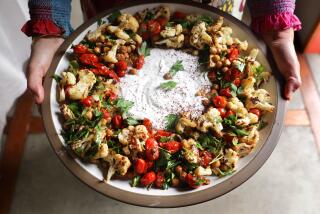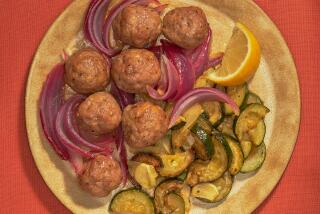IN THE KITCHEN : Ratatouille: Greater Than the Sum of Its Parts
- Share via
So far, my pampered, cosseted vegetable plants have produced neither tomatoes nor peppers nor eggplants. But I have tuned up the grill and barbecued a few dinners, meaning it’s time for ratatouille. The garden will just have to catch up.
To me, few things match the taste of grilled meat quite as well as this changeable vegetable stew. A little smoky, a little sweet, its melting tenderness plays well against the crisp char of a good steak or grilled chicken.
It’s great summer food for reasons beyond taste. One of the things I like best about ratatouille is the way it mutates from dinner to dinner, depending on what ratios of vegetables and herbs are at hand and how I feel when I’m cooking it.
This is clean-out-the-fridge food. If I have a lot of zucchini, then the ratatouille will be firmer and sweeter. If there’s more eggplant, it’s softer and smokier. It’s rare that I have too many peppers--any surplus usually winds up being grilled, peeled and stored covered with oil--but if I happen to have green or yellow instead of red peppers, they go in the dish and the final result changes subtly with the substitution.
*
It’s the same with herbs. I think there should always be some parsley and probably some basil as well, but really, I use whatever I have in the garden. My ratatouille underwent a make-over when I moved a few years ago. I threw a couple of stems of a big bush that I thought was Greek oregano in the pan, but it turned out it was marjoram instead. What the heck, I like it anyway. Another time, I added summer savory just to see what that was like. It was good too.
There’s a ratatouille that I make when I’m in a hurry--cook the onions, then the eggplant, then peppers, zucchini and tomatoes all in the same pot. Then there’s the ratatouille I make when time is on my side. That’s the one I like the best and--since it’s little more trouble to make a double or triple recipe--I invariably wind up with enough for two or three meals.
I make this extended version of ratatouille by cooking each ingredient separately, then combining them for a final simmer. This way, each vegetable keeps some of its identity, making for a more varied and colorful stew. At least, that’s how I figure it.
I thought it was my idea--that’s also the way I cook vegetables to go with stews and boiled dinners--but it turns out it’s been all over the place and I just never noticed. In fact, in Richard Olney’s new cookbook, “Lulu’s Provencal Table” (HarperCollins: 1994; $35), there is a ratatouille built along these lines.
*
There are a couple of differences: Olney--or more accurately, Lulu Peyraud, whose recipes he’s brought to print--grills the peppers first and then cooks the final melange for more than two hours.
Grilling the peppers I can go for; not so the long cooking. While some people like ratatouille to be a jammy, almost spreading consistency, I like mine with some tooth left and a little textural diversity.
But hey, with a dish like this, fix it however you want. It’s summer and there’s no sense getting worked up over something this good.
RATATOUILLE Olive oil 1 yellow onion, coarsely chopped 3 cloves garlic, minced Salt Freshly ground pepper 1 1/2 pounds eggplant 3 sweet red peppers 3 small zucchini, to equal 1 pound, ends trimmed and soaked in cold water 30 minutes 6 plum tomatoes, peeled, seeded and chopped 1 tablespoon balsamic vinegar 3 tablespoons assorted fresh herbs (parsley, thyme, basil, marjoram and oregano)
Heat 1 tablespoon olive oil in medium non-stick saute pan over medium-high heat. When hot, add onion and cook, stirring until translucent but not brown, about 3 to 5 minutes. Add garlic and cook, stirring constantly, just until onion begins to brown. Do not let garlic brown. Season to taste with salt and pepper. Remove to mixing bowl.
If using slender Asian eggplant, cut into quarters lengthwise and then into 1-inch sections, without peeling. If using round Italian eggplant, trim top and bottom, peel and cut into 1-inch dice.
Using same saute pan, heat another tablespoon olive oil over medium-high heat and add eggplant. Cook, stirring constantly, 5 minutes or until eggplant begins to brown. Reduce heat to medium and continue cooking until eggplant is rather soft, about another 10 minutes. Season to taste with salt and pepper. Combine with onion in mixing bowl. If necessary, divide eggplant in half and repeat, using another tablespoon oil.
Remove tops and bottoms of peppers, cut in half lengthwise and remove seeds and fibers. Cut into 1/2-inch strips lengthwise and then into 1-inch dice. Again using same saute pan, heat another tablespoon olive oil over medium-high heat and, when hot, add peppers. Cook, stirring, until peppers become tender, about 5 to 10 minutes. Season to taste with salt and pepper. Combine with onion and eggplant in mixing bowl.
Cut zucchini into quarters lengthwise and then into 1-inch sections. Using same saute pan, heat another tablespoon olive oil over medium-high heat and add zucchini, stirring constantly until zucchini just begin to brown. Reduce heat to medium and cook until tender-crisp. Season to taste with salt and pepper. Combine with onion, eggplant and peppers in mixing bowl.
Increase heat to high and add tomatoes to saute pan. Stir and add balsamic vinegar. Cook briefly, scraping bottom of pan to get up any brown bits, pour over vegetables and stir to combine.
Empty contents of mixing bowl into large saute pan and cook over medium-low heat until vegetables are cooked thoroughly. Onion, eggplant and peppers should be very soft, and zucchini should still have some bite. During last 5 minutes, add mixed herbs and stir well. Taste again. Adjust seasonings, if necessary. Serve hot or at room temperature. Makes 6 servings.
Each serving contains about: 144 calories; 60 mg sodium; trace cholesterol; 9 grams fat; 15 grams carbohydrates; 3 grams protein; 2 grams fiber.
More to Read
Eat your way across L.A.
Get our weekly Tasting Notes newsletter for reviews, news and more.
You may occasionally receive promotional content from the Los Angeles Times.









